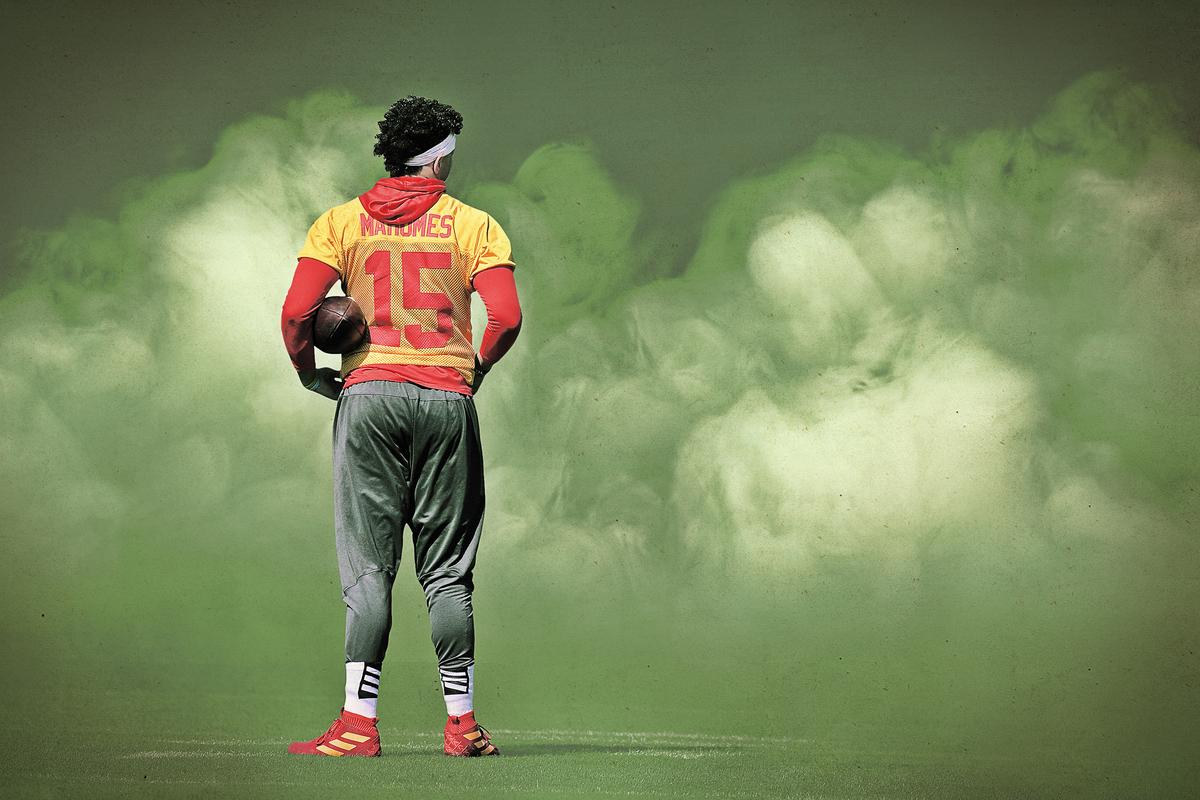
The NFL thought it had time on its side. Its season had ended when the coronavirus first began to shut down the country in March. While other leagues and events, like the NBA regular season and NCAA basketball tournaments, abruptly suspended their operations, the NFL had almost six months before the first game of the 2020 season. It was ample time, league personnel assumed, to learn best practices. NFL commissioner Roger Goodell expressed his optimism on the first night of the draft in late April. “We’ve still got three and a half months before we kick off, so I think what we’re going to do is obviously help be part of the solution,” he said. “Try to help get our economy back, our country back.”
The remote draft went off without a hitch and kept the league on its timeline. Even medical experts were cautiously optimistic: “I would hope that by the time you get to September it’s not gonna be the way it is right now,” Dr. Anthony Fauci, the federal government’s top infectious disease expert, told NBC Sports’ Peter King in May. Through the spring and into the summer, the league has remained adamant that the start of the season would begin as scheduled. “Training camps are expected to open on the normal schedule,” NFL executive vice president Jeff Pash said on a conference call at the end of June.
Two weeks into July, circumstances have not improved. In fact, things are getting worse. More tests are being conducted in the U.S.—there were 15 million coronavirus tests in June, tripling its number from April—but cases have risen in 45 states; last Friday set a new single-day record with more than 67,000 new positive tests nationwide. Safety protocols to help mitigate the spread of the virus, like social-distancing measures and mandating wearing masks, vary widely at the state level; what’s permitted in Dallas may not be in Philadelphia, Buffalo, Chicago, or Phoenix.
For months, the NFL and NFLPA, in consultation with medical experts, have been trying to figure out how they’ll conduct training camps, not to mention the season. They’ve struck agreements on training camp sites and social-distancing measures and developed protocols for air travel and post-practice showers. Still, the TBDs seem endless, and players have started to ask whether the July 28 reporting date set for the majority of them is unrealistic.
Absent a coherent national policy for how to contain the virus, the NFL and NFLPA are trying to design their own universal guidelines. The two sides have competing interests, especially when it comes to the pandemic’s potential financial impact. They’re attempting to solve for the right balance of safety and profit so that 32 teams can operate in 22 states, with more than 2,000 players and even more coaches, trainers, and other personnel. And they’re running out of time.
The league and the NFLPA agreed to a new labor deal in March, so there’s at least a framework both parties can operate within. The CBA requires players to report for training camp 47 or 48 days before the regular-season opener, depending on whether their opener is on Sunday or Monday. One issue that has already emerged as a point of contention between the two sides is the preseason. The league elected to cancel two of the four preseason games this year, but the NFLPA board issued a unanimous recommendation that the entire slate be canceled.
The board’s rationale is that, since the pandemic has suspended normal offseason training and activities, players need more time to get in shape before the regular season begins. In an open letter to membership last week, NFLPA president J.C. Tretter, a center for the Cleveland Browns, cited a 25 percent increase in injuries after the 2011 lockout, including 44 percent more hamstring injuries and twice as many Achilles injuries. Tretter argued that players are in even worse physical shape now because, unlike in 2011, most gyms and training facilities have been shut down since March.
As far as the preseason goes, though, all the NFLPA board can do is make its recommendation. The CBA allows the NFL to stage preseason games and, as of now, the league is sticking with two, scheduled for what would have been the second and third weeks of the original preseason schedule.
Setting the schedule for training camp and preseason games is the easy part. But what happens when players, coaches, and personnel gather in the same place for the first time? There’s been some progress on health and safety protocols, though significant issues like the frequency of testing are still being worked out.
On July 3, the NFL and NFLPA signed on to a 42-page document that outlines protocols for training camp and the preseason. The document includes a plan for educating players, coaches, and all team employees on proper hygiene and social distancing, requirements for spacing lockers 6 feet apart, limiting strength-and-conditioning workouts to groups of 15 players or fewer and holding meetings of more than 20 virtually. Anyone entering a team facility is required to fill out a form screening them for COVID-19 symptoms and they must have their temperature taken. Anyone with a temperature above 100.4 degrees Fahrenheit will be sent home and isolated.
Anyone who might spend time around an NFL team will be sorted into one of three tiers. The tiers allow for varying degrees of access to people and places in and around facilities and different requirements for social distancing and the use of protective equipment:
- Tier 1 includes players, coaches, trainers, doctors, and equipment managers. It’s the only group that is allowed to work in close contact with others or work without protective equipment such as masks.
- Tier 2 includes some facility staff, owners, some assistant coaches, PR staff, general managers, football operations staff, in-house media, and others who occasionally need access to restricted areas like locker rooms where Tier 1 individuals are present, but can otherwise maintain social-distancing measures. This group is required to wear PPE while at the facility.
- Tier 3 includes some field maintenance workers, cleaning staff, camera operators, and security officers who will have some facility access but never need to enter restricted areas like locker rooms where tier 1 or 2 individuals are present.
There are limits on how many individuals from each tier and in total can be at a facility on any given day.
There’s also a plan for when someone tests positive or exhibits coronavirus-related symptoms. Anyone who tests positive and experiences symptoms will be required to quarantine for at least 10 days. They can’t return to the facility until at least 72 hours after their last symptoms and not until they are medically cleared. Those who test positive but are asymptomatic can return after five days if they have two consecutive negative tests at least 24 hours apart. There’s a separate flowchart with guidance for what to do with those who may have been exposed to someone who tests positive.
The NFLPA would like to test players every day, but a testing plan hasn’t been finalized for training camp yet. ESPN’s Jeremy Fowler reported that the NFL and NFLPA management councils are scheduled to meet on Monday to discuss terms.
Frequent testing could cut short the length of quarantine. There’s evidence that the incubation period of the coronavirus can be as long as 14 days, which is why that’s been the standard length of quarantine for those with exposure to the virus. The median time from exposure to symptom onset, though, is four to five days, so it’s possible that frequent testing could allow teams to bring back players who’ve been exposed much sooner than the 14-day period without causing outbreaks. Key word: possible.
“Nobody really knows the answer to that yet,” said Dr. Davidson Hamer, a global health professor at Boston University and an infectious disease specialist at Boston Medical Center. “Could a testing strategy with frequent testing every other day or even every day allow you to pull them out of quarantine and get them on the field faster? Maybe.”
Teams will have positive cases, so the challenge becomes mitigating the spread and preventing an outbreak. There’s no definitive scientific threshold at which point an outbreak becomes uncontrollable. In every team’s core group of Tier 1 individuals, epidemiologists I spoke to estimated that if 5 to 10 percent of that population tested positive for the coronavirus it would be reasonable to assume that exposure, which necessitates quarantine, would be widespread. When the virus is that prevalent in a group, they say, contact tracing stops being effective because there are too many points of contact to trace.
“I’d say as low as 10 percent could lead to the whole team needing to be tested and quarantined,” said Hamer.
“If you had five or six people test positive in a short period of time, I’d be concerned,” said Dr. Daniel Kuritzkes, chief of the Division of Infectious Diseases at Brigham and Women’s Hospital in Boston.
“This is the same thing that, for example, cruise ships are thinking about,” said Dr. Amesh Adalja, a senior scholar at the Johns Hopkins Bloomberg School of Public Health.
It is not a good sign in 2020 when your industry is being compared to cruise ships.
The size and scope of what’s left to figure out makes the long list of other rules that have been agreed to feel almost trivial by comparison. The league has protocols in place for bus rides (50 percent maximum capacity), washing showers (with hospital-grade EPA list N disinfectants), eating at restaurants (don’t), and ordering food on the road (takeout subject to approval; Postmates or other contactless delivery preferred). There is an expectation that training camp rosters, which normally start at 90, will be reduced.
What this adds up to is a plan to play without an NBA-style bubble. NFL teams are planning to operate out of their regular facilities, with players commuting from their homes. For training camp, teams like the Cowboys, who usually have camp in California, or Washington, which typically goes to Richmond, Virginia, won’t travel. Teams must provide hotel rooms to players who want to stay in them, whether to protect at-risk family members or for any other reason, but can’t make players stay in hotels. Still, though they will be subject to extra restrictions, NFL players and personnel are planning to travel between states for preseason games, and certainly during the regular season, while remaining part of their home communities.
“We do not feel it’s practical or appropriate to construct a bubble,” NFL chief medical officer Dr. Allen Sills said on a conference call on June 17.
Several epidemiologists and infectious disease experts told me that bubbling thousands of players and staff for six months is impractical. The NFL’s players and personnel will be part of 32 different communities and subject to various levels of risk within those communities.
“So the Patriots living here in Massachusetts—probably pretty minimal risk,” said Kuritzkes. “The Cowboys living in Texas or the Dolphins living in Miami? I’d be kind of worried based on projections at the moment.”
One complicating factor is that the Patriots living in Massachusetts eventually have to play the Dolphins living in Miami, with players lining up across from one another.
Another unresolved issue is under what circumstances players can opt out of playing this season because of safety concerns, and how choosing to do so would affect their pay and contracts. An NFLPA source told me that if a player were to opt out, his contract would essentially “toll,” or have most of its terms put on pause until the next year. The NFLPA wants players who opt out to still get paid any signing bonus or roster bonus money they were due this year, though teams could potentially have the option to pay it out next year if they’d prefer.
The NFLPA also wants COVID-19 to be classified as a “football injury,” which would mean players would still be paid if they miss time while they are sick. It would also afford far more protections and rights to benefits if they get cut while sick. There are also worker’s compensation questions about how any of the coronavirus’s long-term implications would be covered; the answers won’t be easy, because the long-term effects are still unknown.
Most players who have spoken publicly, from Patrick Mahomes to Mark Ingram to J.J. Watt to J.C. Tretter to Steelers defensive lineman Cam Heyward, have said they’re eager to play as long as they feel safe.
“Everyone I’ve heard from is just trying to find out more because they want to go back to football,” Heyward, who is Pittsburgh’s player representative to the PA and who has asthma, said on NFL Network.
The NFL’s worst-case scenario, in which the virus spreads so widely that contact tracing no longer draws a tree with branches of exposure but rather an impossibly tangled web, is one much of America is in right now.
“We have way too much virus across the country for [contact tracing] right now,” Dr. Anne Schuchat, principal deputy director for the CDC, said in an interview with The Journal of the American Medical Association on June 29.
The NFL can’t insulate itself from the country’s problems. Right now, it’s also suffering from a lack of national solutions, or even guidelines. Germany’s Bundesliga has been offered as a success story for having been the first league to restart, without fans, and finishing its season without a single positive test. But Germany has been averaging around 500 new cases per day. When the league resumed in May, it had national guidelines in place like a contact ban, limiting citizens’ interactions with people from other households, which applied in every team’s city.
In the United States, beyond following state and local guidelines, the NFL has to set its own policy. That means only interested parties will be involved in writing the rules, with all the inevitable squabbles and potential choices between safety and job performance that brings. The number of variables is getting overwhelming, especially for players getting antsy waiting to take physicals and finalize contracts signed earlier in the offseason. When was the last time someone gave you a satisfying answer about the future?
Sports are supposed to be one reward of a well-functioning society. The league’s timeline asks that sports function better than society. That’s looking like a steeper challenge by the minute.

